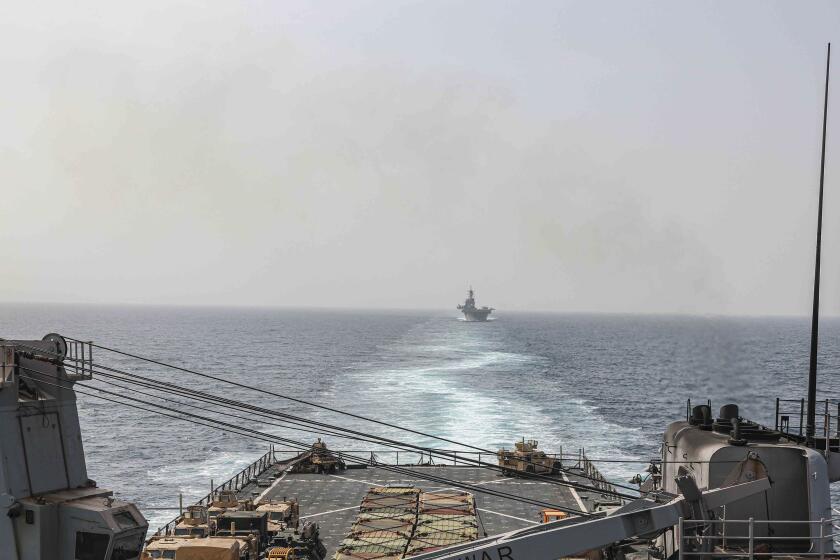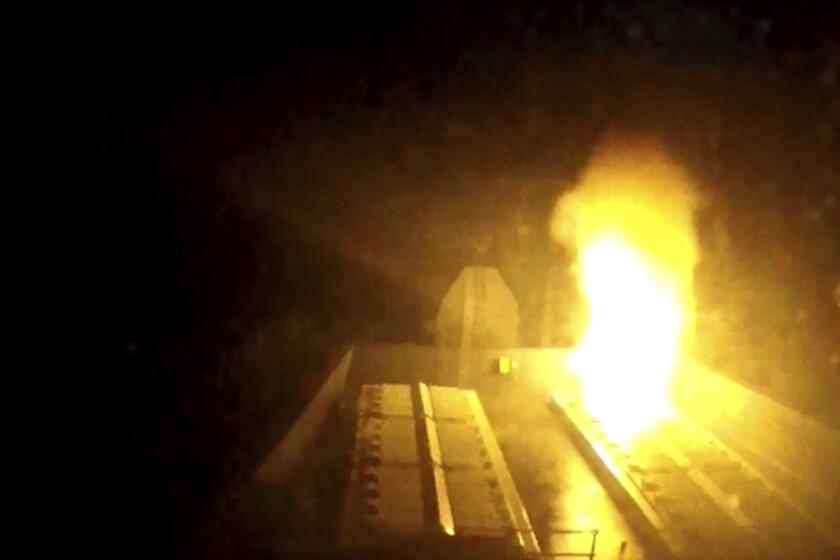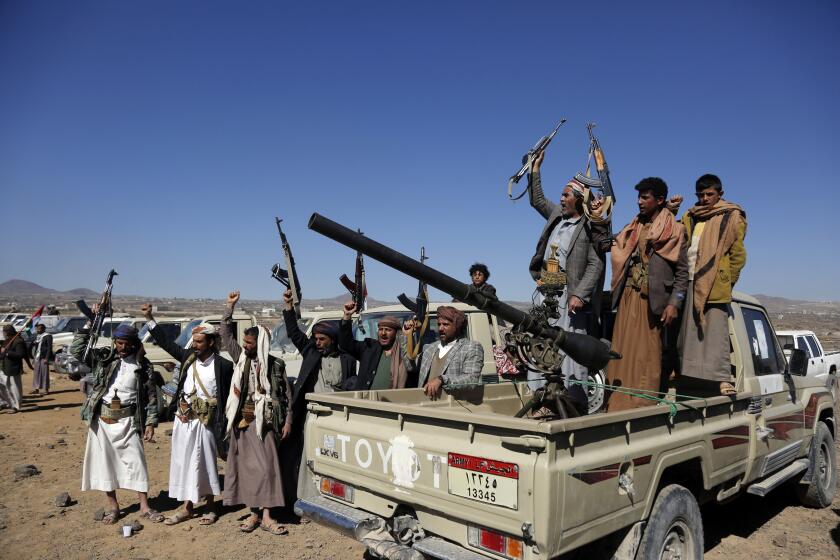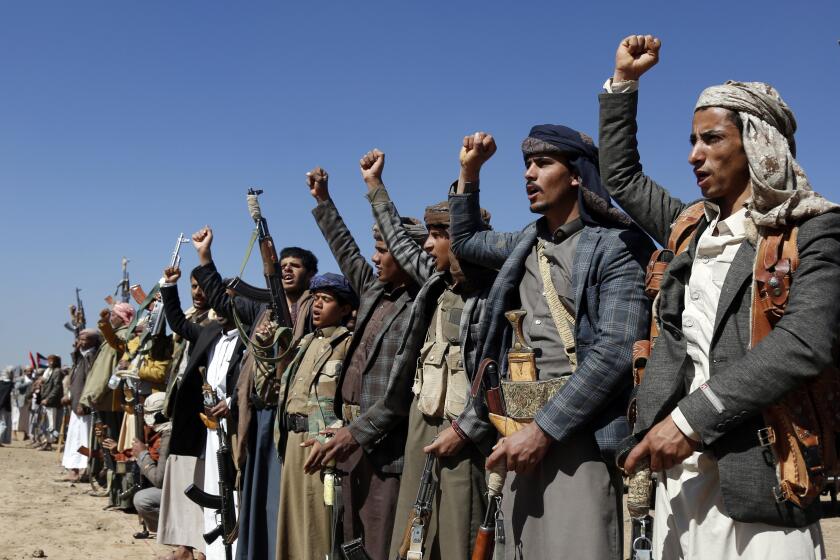U.S., British militaries launch new round of joint strikes against Houthi sites in Yemen
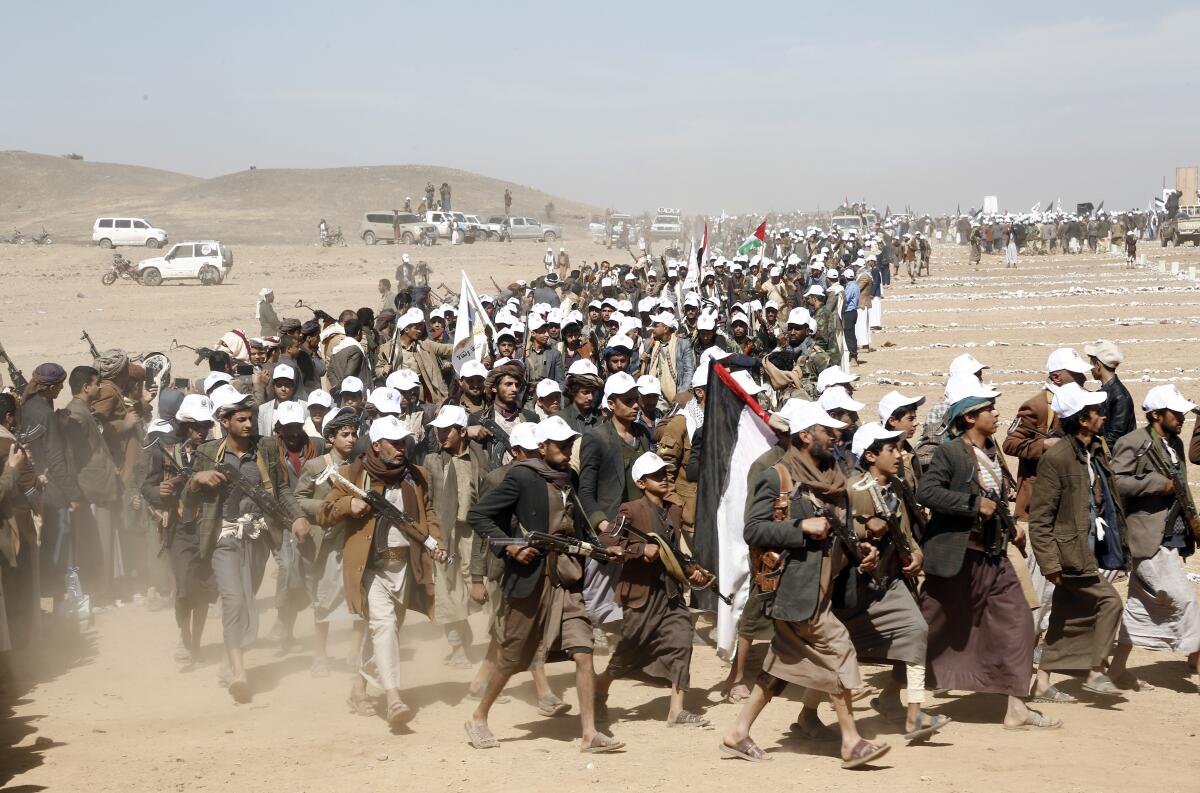
- Share via
WASHINGTON — The U.S. and British militaries bombed eight locations used by the Iranian-backed Houthis in Yemen on Monday night, the second time the two allies have conducted coordinated retaliatory strikes on an array of the rebels’ missile-launching capabilities.
According to officials, the U.S. and U.K. used warship- and submarine-launched Tomahawk missiles and fighter jets to take out Houthi missile storage sites and launchers. The officials, who spoke on condition of anonymity to discuss a military operation, said Australia, Bahrain, Canada and the Netherlands contributed to the mission, including with intelligence and surveillance.
In a statement, the six allied nations said the strikes specifically targeted an underground storage site and locations associated with the Houthis’ missile and air surveillance capabilities. “Our aim remains to de-escalate tensions and restore stability in the Red Sea, but let us reiterate our warning to Houthi leadership: we will not hesitate to defend lives and the free flow of commerce in one of the world’s most critical waterways in the face of continued threats,” they said.
The U.S. and British militaries bombed more than a dozen sites used by the Iranian-backed Houthi rebels in Yemen, in a massive retaliatory operation.
Britain’s Ministry of Defense confirmed that four Royal Air Force Typhoon jets struck “multiple targets at two military sites in the vicinity of Sanaa airfield” with precision-guided bombs. The strikes, said Defense Secretary Grant Shapps, were “aimed at degrading Houthi capabilities” and would “deal another blow to their limited stockpiles and ability to threaten global trade.”
The operation came about 10 days after U.S. and British warships and fighter jets struck more than 60 targets in 28 locations. That was the first U.S. military response to what has been a persistent campaign of Houthi drone and missile attacks on commercial ships since the start of the Israel-Hamas war in October.
The Houthis’ media office said in an online statement that raids targeted Yemen’s capital, Sana. And Jamal Hassan, a resident from south Sana, told the Associated Press that two strikes landed near his home, setting off car alarms in the street. An Associated Press journalist also heard aircraft flying above the skies of Sana overnight Monday.
Al Masirah, a Houthi-run satellite news channel, said there were air raids on three areas: Al Dailami Air Base just north of the capital; Sarif, northeast of the city center; and Al Hafa, south of Sana.
The British and U.S. militaries say that a U.S. warship shot down 14 suspected attack drones over the Red Sea and a Royal Navy destroyer downed another one.
British Prime Minister Rishi Sunak spoke with President Biden earlier Monday. Sunak’s office said the two leaders agreed to take “as needed, targeted military action to degrade Houthi capabilities.”
The latest barrage of allied attacks marks the eighth time the U.S. has conducted strikes on Houthi sites since Jan. 12. And it follows an almost-daily assault on Houthi missile launchers by U.S. fighter jets and ship-based Tomahawks over the last week. The rapid response missions, which officials said go after launchers that are armed and ready to fire, demonstrate the military’s increasing ability to watch, detect and strike militant activities in Yemen.
The chaotic wave of attacks and reprisals involving the United States, its allies and foes suggests that the retaliatory strikes haven’t deterred the Houthis from their campaign against Red Sea shipping, and that the broader regional war that the U.S. has spent months trying to avoid is becoming closer to reality.
For months, the Houthis have attacked ships in the region’s waterways that they say are either linked to Israel or heading to Israeli ports. They say their attacks aim to end the Israeli air-and-ground offensive in the Gaza Strip that was triggered by the Palestinian militant group Hamas’ Oct. 7 attack in southern Israel. But any such links to the ships targeted in the rebel assaults have grown more tenuous as the attacks continue.
The U.S. has launched more missile strikes on Houthi-controlled sites in Yemen, the fourth time in days that it has directly targeted the group.
The U.S. and allies warned of retaliation for weeks, and the White House and a host of partner nations issued a final warning on Jan. 3 to the Houthis to cease the attacks or face potential military action.
That threat, however, had little noticeable effect. The Houthis continued to attack ships, including at times appearing to target U.S. Navy and U.S.-owned ships, in addition to the wide range of commercial vessels.
Of the eight strike missions on Yemen this month, all but the two with Britain were conducted by the U.S. military alone. Five of the latest strikes were labeled self-defense to take out missiles ready to fire. The most recent, on Saturday, struck and destroyed a Houthi anti-ship missile that was aimed into the Gulf of Aden and was prepared to launch, according to Central Command.
The Biden administration has also put the Houthis back on its list of specially designated global terrorists. The sanctions that come with the formal designation are meant to sever violent extremist groups from their sources of financing, while allowing vital humanitarian aid to continue flowing to impoverished Yemenis.
The move to pile financial sanctions on top of U.S. military strikes is the Biden administration’s latest attempt to stop the militants’ attacks on global shipping.
U.S. defense officials have said they believe the strikes have degraded the Houthis’ weapons and strike capabilities. But Biden and others have acknowledged that the rebels are well equipped by Iran and are likely to continue the attacks.
The Houthis, meanwhile, have made it clear that they have no intention of scaling back their assault. In the wake of the first U.S. and British joint attack, Hussein Ezzi, a Houthi official in their Foreign Ministry, said, “America and Britain will undoubtedly have to prepare to pay a heavy price and bear all the dire consequences of this blatant aggression.”
The continued harassment of the ships has driven the U.S. and international partners to take extraordinary steps to defend them through a joint mission named Operation Prosperity Guardian, in which they provide a protective umbrella for vessels traveling the critical waterway that runs from the Suez Canal down to the Bab al Mandab strait.
About 400 commercial vessels transit the southern Red Sea at any given time. And the violence has prompted companies to reroute their ships, sending them around Africa through the Cape of Good Hope instead, a much longer and less efficient passage.
Associated Press writers Jack Jeffery in London, Ahmed al-Haj in Sana and Jill Lawless in London contributed to this report.
More to Read
Sign up for Essential California
The most important California stories and recommendations in your inbox every morning.
You may occasionally receive promotional content from the Los Angeles Times.
